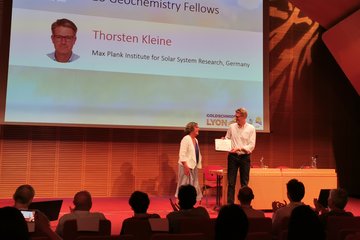Alle Typen
21.
Konferenzbeitrag
Properties of resonant trans-Neptunian objects based on Herschel Space Observatory data. AAS/Division for Planetary Sciences Meeting Abstracts 48, 113.06, (2016)
22.
Vortrag
The Direct Events Ion Product on RAPID. 29th Cluster workshop, Lanzarote, Canary Islands, Spain (2019)
23.
Vortrag
Heavy ions in the terrestrial magnetosphere: Cluster RAPID observations. 29th Cluster workshop, Lanzarote, Canary Islands, Spain (2019)
24.
Vortrag
Asteroid In-situ Interior Investigation - 3way: Understanding the formation processes and evolution of small solar system bodies. EPSC-DPS Joint Meeting 2019, Geneva, Switzerland (2019)
25.
Vortrag
Photometry and radiometric modeling of Transneptunian objects in support of the Herschel key program 'TNOs are Cool'. EPSC-DPS Joint Meeting, Geneva, Switzerland (2019)
26.
Vortrag
The RAPID Direct Events product: what it is and how to use it. 24th Cluster Cross-Calibration Workshop, Maspalomas, Gran Canaria, Spain (2018)
27.
Vortrag
Two methods to derive RAPID/IES long-term correction functions. 24th Cluster Cross-Calibration Workshop, Maspalomas, Gran Canaria, Spain (2018)
28.
Vortrag
Preparing for the DISCUS mission: Target selection and radiation environment. Asteroids and Comets - Inside Out Workshop (ACIO2018), Tampere, Finland (2018)
29.
Vortrag
Energetic Particles in Geospace: Characteristics, Sources and Impact Seminar. Istituto di Astrofisica Spaziale e Fisica Cosmica, Milano, Italy (2018)
30.
Vortrag
What is a rubble pile asteroid? DISCUS The Deep Interior Scanning CubeSat mission to a near-Earth rubble pile asteroid will find out. Rocks \& Stars II, Göttingen, Germany (2017)
31.
Vortrag
Analysis of RAPID electron fluxes after corrections for the long-term detector decay. 23th Cluster Cross-Calibration Meeting, Mallorca, Spain (2017)
32.
Vortrag
DISCUS: Deep Interior Scanning CubeSat - A mission for imaging the interior structure of a rubble pile asteroid using radar tomography. 1st IUGG Symposium on Planetary Science, DLR Adlershof, Berlin, Germany (2017)
33.
Vortrag
Energetic particles and chorus waves during injections. ISSI team meeting, Bern, Switzerland (2016)
34.
Poster
Calibration of RAPID/IES 3D electron data: detector-to-detector corrections and long-term degradation. 29th Cluster workshop, Lanzarote, Canary Islands, Spain (2019)
35.
Poster
RAPID detection of heavy ions in the magnetosphere. 5th Cluster-Themis Workshop, Chania, Greece (2018)
36.
Poster
Update on the long-term calibration of RAPID/IES 3D electron data. 5th Cluster-Themis Workshop, Chania, Greece (2018)
37.
Poster
Physical properties of the Haumea family observed at far-infrared wavelengths. Scientific Workshop on the Transneptunian Solar System, Coimbra, Portugal (2018)
38.
Poster
Validation of the RAPID/IES 3D electron distributions after correcting for long-term sensitivity decrease. 27th Cluster Workshop, Bled, Slovenia (2017)
39.
Poster
Correcting the RAPID Imaging Electron Spectrometer data set for long-term sensitivity decrease. 4th Cluster-THEMIS workshop, Palm Springs, USA (2016)
40.
Poster
Long-term decay effect of the RAPID Imaging Electron spectrometer. Cluster 15th and Double Star 10th anniversary workshop, Venice, Italy (2015)











